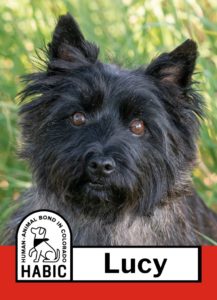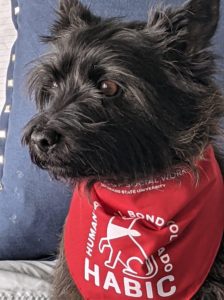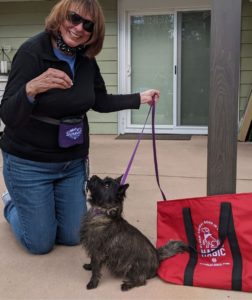On a warm spring afternoon, Lucy and I stand in front of a tall stockade gate in suburban Fort Collins, Colorado. On the other side of the gate is a panel of 3 judges who will observe Lucy and I perform all of the tasks required to become a therapy team.
We have prepared for this moment, but I still feel nervous and unsure. I look down at Lucy. Her only concern is when can she get those treats that she knows are in my pocket.
It is then I realize that we are a team…that she will do what she is asked to do, with certainty and joy. And I will support her with clear direction and encouragement. That knowledge fills me with confidence. I take a deep breath and push through the gate.
 When Lucy came into my life as a young adult dog, I knew almost immediately that her smart, sweet, and engaging personality were gifts I wanted to share with others. She is eager to learn, learns quickly, and loves having a job.
When Lucy came into my life as a young adult dog, I knew almost immediately that her smart, sweet, and engaging personality were gifts I wanted to share with others. She is eager to learn, learns quickly, and loves having a job.
The road leading to this moment was made longer by the pandemic. I began researching what it would take to become a therapy team. Several articles recommended starting out by obtaining a Canine Good Citizen title, so I signed up at a local training facility. When we completed that course and obtained the title, I contacted the therapy organization I wanted to become a part of and found out they would not be holding any in-person training classes for a while due to the pandemic. So Lucy and I took some additional classes, adding the Novice Trick dog title to her accomplishments.
After more than a year of taking local dog training classes, I received the good news that therapy dog training with HABIC (Human-Animal Bond in Colorado) would begin holding training sessions via teleconference in January of 2021. Before starting class, we were required to fill out a membership application form, a dog behavioral form (several pages of questions about your dog and her behavior), and a medical evaluation form for your veterinarian to fill out health history, perform an annual exam and fecal test, and answer behavioral questions about your dog. As the handler, I was also required to pass a professional background check.
What were the training classes like?
Training sessions were held once a week for an hour and spanned 12 weeks. During the training sessions we watched videos, after which the trainer would ask us to perform the training with our dogs and she would provide feedback and answer questions. We had access to Google classroom where we could watch the videos on our own and see all of the topics and training that would be covered during the course, plus all of the exercises we would be required to successfully complete in order to become a certified therapy team.
 Here are the skills we needed to complete during our final evaluation:
Here are the skills we needed to complete during our final evaluation:
- Walking at heel: the dog remains at the handler’s left side while walking and executing left and right turns, and the dog sits in heel position on the handler’s left side whenever the handler stops walking.
- Sit, down, stand: dog sits, lays down, and stands when cued by the handler.
- Treat delivery: evaluator places a treat on a flat hand in front of the dog’s nose…the dog cannot take the treat until given permission to do so.
- Go say hi: handler directs dog to leave them and go to another person for petting/attention.
- Leave it: dog is walked past kibble that is placed on the ground and is told to “leave it”.
- Recall and finish: dog remains in a “wait” until handler is 20 feet away. Handler calls the dog, dog comes and sits directly in front of the handler. Dog must be able to “finish left” (come to the handler’s left side, turn to face forward and sit) and “finish right”(dog goes to handler’s right side, circles behind the handler until in heel position on the left, and sits down), whichever is cued.
- Stay (sit or down): handler places dog in sit or down, asks dog to stay, and moves 20 feet away from the dog. Dog and handler remain in position for 1 minute, then handler returns to the dog, walking behind the dog and moving to the dog’s left side. Dog is then released from the stay.
- Stay (sit or down) with distraction: dog sits next to handler in heel position and is asked to stay while an evaluator walks within 5 feet of the dog and drops kibble. Dog must also stay while evaluator passes by within 5 feet using a walker.
- Sit for pets: dog remains sitting next to handler while evaluator comes over and pets the dog.
- Stand for pets: dog stands next to seated evaluator to receive pets.
- Walk through crowd: dog walks past several people and remains in heel position with the handler.
- Walk through dogs: dog is walked past multiple dogs and remains in heel position with the handler.
 Lucy was also required to learn 3 “fun” skills that can be used while working in a therapy session. We chose running through an agility tunnel, jumping over an agility jump, and finding treats under tennis balls placed in a muffin tin.
Lucy was also required to learn 3 “fun” skills that can be used while working in a therapy session. We chose running through an agility tunnel, jumping over an agility jump, and finding treats under tennis balls placed in a muffin tin.
Dogs will not be certified if they exhibit any of the following behaviors:
- Any form of aggression toward a person.
- Excessive barking or whining.
- Excessively licking a person.
- Jumping on or pawing at a person.
- Urinating or defecating indoors.
In between sessions, Lucy and I would practice all the skills every day for 5 to 10 minutes. I kept the sessions short and fun, using treats and praise. Lucy soon learned that when I put on her collar it would mean work had begun, and she was so excited and would leap about in anticipation of practice. It was easy to stay motivated!
Ideally training should take place in a variety of situations with distractions, but this was not feasible due to the pandemic. For instance, we didn’t practice walking by multiple dogs or through crowds. We saw both of these exercises for the first time at final evaluation, but thankfully Lucy took them in stride and passed them both.
 Lucy scored “meets expectations” for 3 exercises, and “exceeds expectations” for the other 9 exercises plus her 3 fun activities! She also passed her behavioral, and we became a certified therapy team.
Lucy scored “meets expectations” for 3 exercises, and “exceeds expectations” for the other 9 exercises plus her 3 fun activities! She also passed her behavioral, and we became a certified therapy team.
If your dog enjoys learning and being with people, I highly recommend becoming a therapy team. It takes commitment, consistent work, and practice, but we’ve both learned so much. It strengthened the bond we have and we enjoy working together to bring Lucy’s joyful spirit to others.
Lucy is owned, loved by, and partnered with Cathy Cardon.
 About Human-Animal Bond in Colorado
About Human-Animal Bond in Colorado
Founded in 1993, Human-Animal Bond in Colorado (HABIC) is a center in the School of Social Work, part of CSU’s College of Health and Human Sciences. HABIC’S mission is to improve the quality of life for people of all ages through the therapeutic use of companion animals, with particular focus in the areas of community outreach, teaching, and research.
